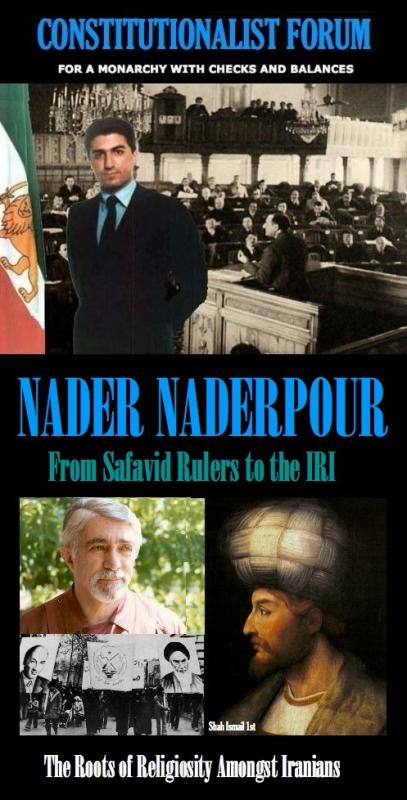
Nader Naderpour explains to Ali Limonadi why he thinks the roots of religiosity in Iranian Society to this day is a heritage of Safavid rule.
Nader Naderpour with Ali Limonadi:
******************************
******************************
“Islamic Democracy”
******************************
******************************
Khatami’s Era of “Islamic Democracy” Seemed largely inspired by the Safavid
Concept of Statehood.
Reformist President Khatami on Islamic Democracy:
Mohammed Khatami on the Impossibility to Separate Religion From Politics
******************************
******************************
SHAH TO WORKERS:
“Stop praying all day and roll up
your sleeves”
******************************
******************************
Shah Admonishes The Working Class: “Stop Praying All Day and Roll Up Your Sleeves”:
During a speech ( exact date, location ? ) at a public gathering of workers, University teachers and industry entrepreneurs, the Shah of Iran deplores the shortcomings in terms of qualified executives and insists on the importance of developing the nation’s technical schools instead of sending workers abroad (to Federal Germany) for further training only to come back boasting about their qualifications only to sit behind a desk. He then criticizes those male traditionalists who refuse to work on days of religious mournings (aka”Azah Dary”) while their wives and or daughters (who normally work half the amount of time in the same companies) as a result often have to double their efforts in order to compensate for the delays.
Also See Related Pictory:
FIRST REFORMIST: Shah aims to break mullahs grip on country
pictory: Girls in Bikini vs Veiled Women on Caspian Sea, Babolsar (1971)
About the Savafids:
Eventhough Safavids were not the first Shia rulers in Iran, they played a crucialrole in making Shia Islam the official religion in the whole of Iran. There were large Shia communities in some cities like Qom and Sabzevar as early as the 8th century. In the 10th and 11th centuries the Buwayhids, who were of the Zaidiyyah branch of Shia,ruled in Fars, Isfahan and Baghdad. As a result of the Mongol conquest and the relative religious tolerance of the Ilkhanids, Shia dynasties were re-established in Iran, Sarbedaran in Khorasan being the most important. The Ilkhanid ruler Öljaitü converted to Twelver Shiism in the 13th century.
Following his conquest of Iran, Ismail I made conversion mandatory for the largely Sunnipopulation. The Sunni Ulema or clergy were either killed or exiled. Ismail I, despite his heterodox Alevi Shia beliefs (Momen,1985), brought in mainstream Ithnā‘ashariyyah Shi’a religious leaders and granted them land and money in return for loyalty.Later, during the Safavid and especially Qajar period, the ShiaUlema’s power increased and they were able to exercise a role, independent ofor compatible with the government. Despite the Safavid’s Sufi origins, most Sufi groups were prohibited, except the Nimatullahi order.
Iran became a feudal theocracy: the Shah was held to be the divinelyordained head of state and religion.
In the following centuries, this religious stance cemented both Iran’s internalcohesion and national feelings and provoked attacks by its Sunni neighbors. (More Here)
Other Nader Naderpour Blogs:
Nader Naderpour: How Rennaissance inspired Iran’s Constitutional Revolution
SOURCES OF FURY:Nader Naderpour on origins of IRI’s “Death Slogans” towards US and Israel
Related Blogs:
Shah Admonishes The Working Class: “Stop Praying All Day and Roll Up Your Sleeves”
Constitutionalist Student on ’79 Revolutionaries Infatuation with Arabs
Constitutionalist’s Rebuttal of Republican Assessment that Revolution was “Highjacked”
Shadi Sadre’s Rebuttal of Massoud Behnoud’s Endorsement of IRI Constitution
How YOUR “Green” Color Was Chosen & By WHOME !
Constitutionalist’s Critics of Shamlou’s deemed ‘Insults’ towards Ferdowsi’s Shahnameh
Mashallah Ajoudani on Intellectuals and the ’79 Revolution
Pro Moussavi Supporters Try to Discourage Pro Pahlavi Supporters In Rome Rally
Banisadr On Risks and Conditions Of Seeing Reza Pahlavi Restored
Other Constitutionalist Blogs:
HISTORY OF IDEAS: Constitutional Government In Locke’s Second Treatise (Yale University)
Constitutionalist activist debates with Green activist Omid Dana On RP 2’s Leadership
Cyrus Amir-Mokri on Pros and Cons of 1906 Constitution
Young Constitutionalist Explains why he Favors Monarchies over Republics
Constitutionalist’s Critics of Shamlou’s deemed ‘Insults’ towards Ferdowsi’s Shahnameh
Constitutionalist’s Rebuttal of Republican Assessment that Revolution was “Highjacked”
Constitutionalist Student on ’79 Revolutionaries Infatuation with Arabs
Constitutionalist Student’s Views On Shah’s Rule after Mossadegh’s Downfall
Constitutionalist Student Shares Views On Mohammed Reza Shah’s Rule
Constitutionalist Student Shares Views on the Pros and Cons of Reza Shah’s Rule
Political Pluralism and Freedom of Press in Pahlavi Iran
How Genuinely Democratic and Representative was the Parliament in Pahlavi Iran ?
PRAISE FOR REZA SHAH: Adjoudani Slams Lack of Recognition for Pahlavi Dynasty’s Founder






